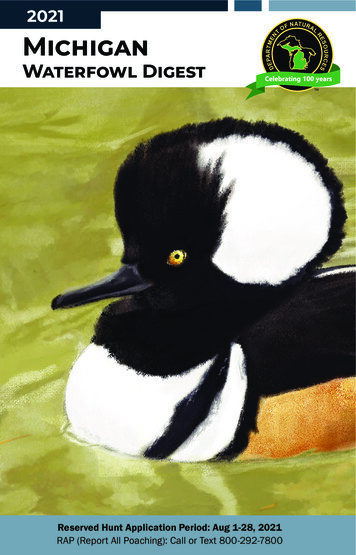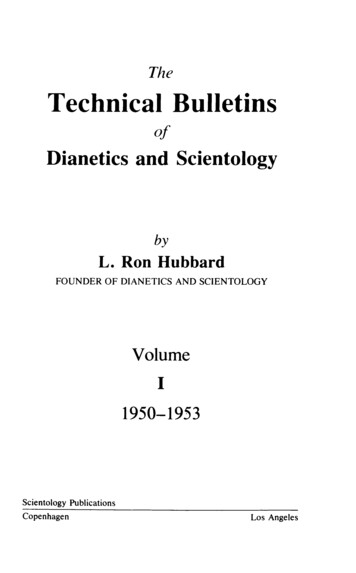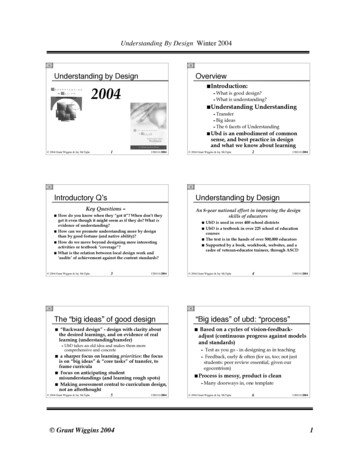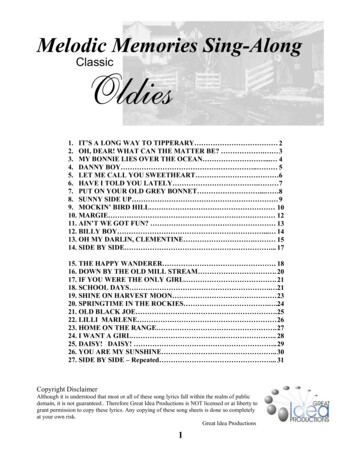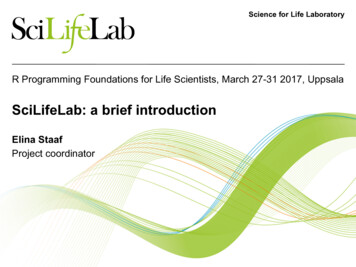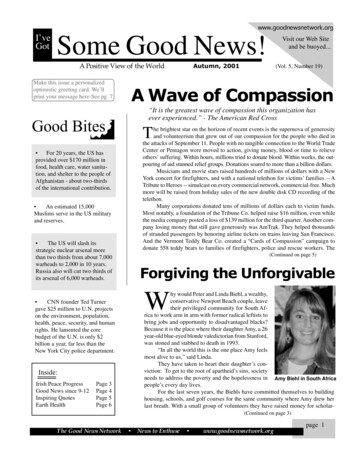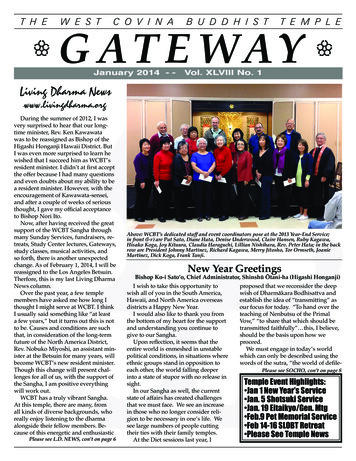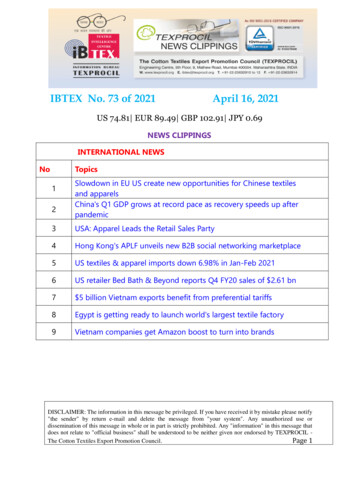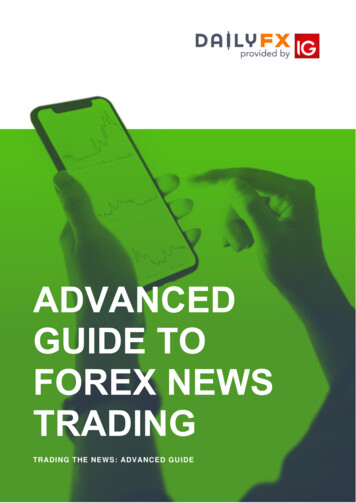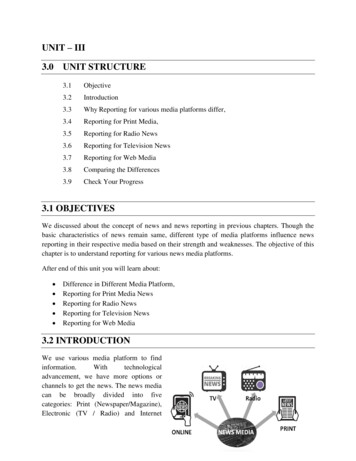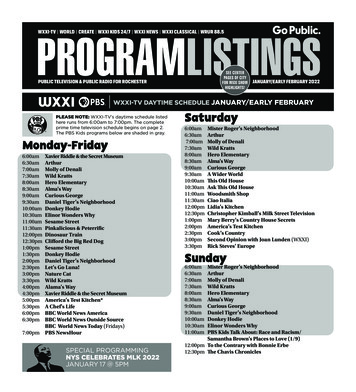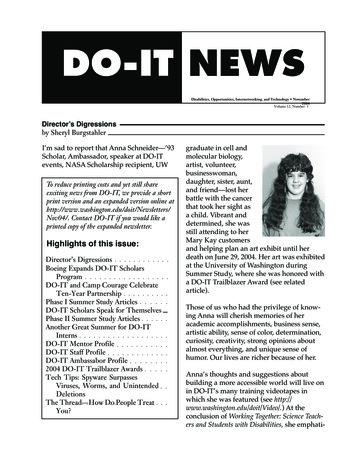
Transcription
DO-IT NEWSDisabilities, Opportunities, Internetworking, and Technology November2004Volume 12, Number 3Director’s Digressionsby Sheryl BurgstahlerI’m sad to report that Anna Schneider—’93Scholar, Ambassador, speaker at DO-ITevents, NASA Scholarship recipient, UWgraduate in cell andmolecular biology,artist, volunteer,businesswoman,daughter, sister, aunt,and friend—lost herbattle with the cancerthat took her sight asa child. Vibrant anddetermined, she wasstill attending to herMary Kay customersand helping plan an art exhibit until herdeath on June 29, 2004. Her art was exhibitedat the University of Washington duringSummer Study, where she was honored witha DO-IT Trailblazer Award (see relatedarticle).To reduce printing costs and yet still shareexciting news from DO-IT, we provide a shortprint version and an expanded version online /. Contact DO-IT if you would like aprinted copy of the expanded newsletter.Highlights of this issue:Director’s DigressionsBoeing Expands DO-IT ScholarsProgramDO-IT and Camp Courage CelebrateTen-Year PartnershipPhase I Summer Study ArticlesDO-IT Scholars Speak for ThemselvesPhase II Summer Study ArticlesAnother Great Summer for DO-ITInternsDO-IT Mentor ProfileDO-IT Staff ProfileDO-IT Ambassabor Profile2004 DO-IT Trailblazer AwardsTech Tips: Spyware SurpassesViruses, Worms, and UnintendedDeletionsThe Thread—How Do People TreatYou? Those of us who had the privilege of knowing Anna will cherish memories of heracademic accomplishments, business sense,artistic ability, sense of color, determination,curiosity, creativity, strong opinions aboutalmost everything, and unique sense ofhumor. Our lives are richer because of her. Anna’s thoughts and suggestions aboutbuilding a more accessible world will live onin DO-IT’s many training videotapes inwhich she was featured (see http://www.washington.edu/doit/Video/.) At theconclusion of Working Together: Science Teachers and Students with Disabilities, she emphati- 1
cally states, “I think it’s very important thatscience teachers understand that peoplewith disabilities can do science. We have theintelligence and capabilities to do it, and it’simportant that we are exposed to sciencejust like people without disabilities are sowe can better make choices about our lives,like what career we want to go into andwhat we want to study.”career interests, and college options. Theycommunicated with DO-IT Scholars, Pals,Ambassadors, and Mentors. They took afield trip to a local university and practicedrequesting accommodations from a professor. I was the lead instructor. Rick Light,Chris Rosenberg, Mamoru Iwabuchi, andBill Taylor provided technical and instructional support. Tracy Benson and AaronCorcoran, two previous campers who arenow in college, stopped by to speak to thegroup about their steps to success.Boeing Expands DO-IT Scholars Programby Sheryl BurgstahlerWith a generous grant from Boeing, DO-ITwas able to fund several Scholars in 2004 inaddition to those funded by the state.Thanks, Boeing! DO-IT invested yourmoney wisely—in preparing skilled collegestudents, workers, and community leadersfor the next generation.Summer Study ’04: What Do thePhase I Scholars Do?DO-IT Phase I Scholars participate in atwo-week, live-in Summer Study session on the University of Washingtoncampus in Seattle, Washington. Theylearn about college life; surf theInternet; interact with peers, staff, andmentors; and have fun. Below, ’04Phase I Scholars share some of theirexperiences. Note that, reluctantly,articles were edited by DO-IT staff tomake them short enough to include inthis publication, and most are foundin the online version of this issue /. Additional articles byScholars can be found in earlier newsletters at http://www.washington.edu/doit/Newsletters/.2004 Courage Campers outside computer labDO-IT and Camp Courage Celebrate TenYear Partnershipby Sheryl BurgstahlerService Dogs: Friends and Workersby Phase I Scholars Vishal and LukasFor the tenth year, DO-IT cosponsored anInternet, College, and Career Preview program as part of the yearly Teen Camp session at Camp Courage, MN. A dozen college-bound teens with disabilities participated. They explored resources on theInternet, developed a website (see http://depts.washington.edu/doitsum/Courage04/) toshare their experiences, and discovered theirlearning styles, internal and external assets,From an observer’s perspectiveMy name is Vishal. In DO-IT Summer Studythis year, we got to know three service dogsand their companions quite well. Throughobserving these dogs and their companions,I learned a lot.2
but it all pays off. I look at this as investing alittle chunk of time to receive an enormousreturn. I thank the organization I gotMystere from for everything they have doneto make owning Mystere possible. You guysare outstanding!These three dogs, Mystere, Fisher, and Silly,are perfect matches for their companionsLukas, Maryann, and Meg, respectively.They were always by their companionsunless it was nighttime and they were “offduty.” The love from these dogs is obvious.At one time, during photo day, Fisher andMystere got up on their companions’ laps tobe in the pictures with them. It is amazingthat they are so obedient and respond totheir companions so well. Which brings meto training for service dogs. From what Iobserved, the dogs and their companionsmust have gone through rigorous training toget to the point where the dogs obey commands so well and for their companions tohave the type of composure necessary toteach their dogs. Although service dogshave training at an organization, they stillhave to learn with their companions!Microsoft Field Tripby Phase I Scholars Andrew and BudOn our Microsoft trip we had a good time.When we got there, we were taken into asoundstage where we heard an interestinglecture about WindowsTM accessibility. Afterthe lecture they brought in pizza and we ateand socialized for a while before the nextactivity began. After lunch, a panel ofMicrosoft employees with disabilities talkedto us. They talked about the assistive devices they use to do their work and theoverall environment of Microsoft. Next, wetoured the Microsoft production studios andlearned about broadcasting.Last but not least, the dogs have fun also!During the evening when we were donewith the day’s classes and had dorm activities, the companions took off the dogs’ workharnesses, which they wear all day when“on duty.” Taking these harnesses off signaled to the dogs that they were “off duty.”Then they would roam around looking forpeople to play with or be petted by. Oneday, Fisher and Mystere were wrestling eachother, with Robert kind of playing as well,while a lot of us watched. It was fun to seethem play and have fun. These three dogsare truly amazing and so are their companions. We love ya pups!We then went to the Microsoft Museumwhere there was a lot to see. There were allkinds of fancy devices and TVs to play withand watch including X-Box and motiondetector games. The trip was fun and full ofinformation.Planetarium Intergalactic Wondersby Phase I Scholars Maryann and MakennaThe DO-IT Scholars got a great opportunityto visit the astronomy building and planetarium at the University of Washingtonduring the 2004 Summer Study. One of thethings that is impressive about theastronomy building is the great accessibilityfor many types of disability needs. Thepowered entrance door is very wide with alarge hand press plate outside. The pressplate could have been more visible for firsttime users with its location identified with asign or light. The elevator to the planetarium is large enough to accommodatethree wheelchairs.From a companion’s perspectiveMy name is Lukas and my service dog isMystere. I love having Mystere as my service dog but, more importantly, as mycompanion. She is always there for me. Ilove knowing that my parents and mybrother can leave me at the house alone, butI don’t ever feel alone, because Mystere isthere. I’m thankful everyday that Mystere isa part of my life. Yes, the paperwork, training, and everyday work is long and hard,3
The Aquariumby Phase I Scholars Meg and KatieMark Claire, an astronomy graduate student, was the speaker for the AstronomyExploration presentation. The informationMark provided about the solar system wasdetailed, and he took the time to explaineverything so that it was easy to understand. The planetarium had very comfortable seating for observing the night sky andviewing the stars and planets. The seatingwas at a good height for transfers fromwheelchairs. Mark was also able to programand reposition the solar system projector togive examples of what it would be like toobserve stars and planets from differentplaces on Earth, including Seattle. It waseasy for everyone to see the large domedscreen because of the circular seating and itgave the feeling of the planets and starsmoving toward you.As you walk into the second building of theaquarium, the otter and seal exhibits are notthe first things you see; you see somepeople, a few exhibits, and the start of along (yet accessible) path to follow alongyour exploration. As you continue downthe hallway, you can see the various sizesand shapes, from side exhibits to wholerooms, and glass walls with animals thatswim with ease.There can be anything from a room ofcrowded people to a few scattered peopletrailing along like sailboats following thewind and flowing with the tide. Taking timeto admire each display, you leisurely tugyour way along, admiring the fast-pacedsharks and salmon until you finally reachthe climax of your trip, the otters and seals.On approaching these magnificent animals,you admire their grace and willingness to bethe center of attention. You take your time tolook upon these highly esteemed mortalbeings and then make your way to the endof your insightful journey.We also had a chance to see pictures of thesurface of Mars taken by the Mars Roversand sent through downloads back to Earth.The pictures showed craters, landscapes,and possible traces of previous water existence. Other pictures Mark showed in theplanetarium were from the Cassini spacecraft that orbited Saturn. The pictures ofSaturn’s rings had a lot more detail thanthose astronomers had previously seen orexpected. Astronomers and scientists gainedinformation about Saturn that was neveravailable to them before. Mark also described the Cassini spacecraft’s entrythrough the Mars atmosphere and its landing on the surface of Mars. The Cassini usedrockets, a parachute, and air bags for thelanding and bounced like a superball onimpact with Mars’s surface!Dorm Activitiesby Phase I Scholars Tracy and LauraThrough the DO-IT Scholars Program, wehave had the opportunity to learn manythings about college. We learned that collegestudents are very busy people. They havequite a bit of homework, projects, andstudying for tests to do. College studentsalso engage in extracurricular activities.There are also many activities that they caninvolve themselves in at the dorms.Mark gave everyone an opportunity to learnmore with open discussion and easily understood answers to all our questions. TheDO-IT Scholars seemed to enjoy “Exploringour Solar System.” It was a great learningexperience and fun at the same time. ThanksMark for your time and a cool fantasticjourney to the stars and planets!At McCarty Hall, where we stayed, there aremany activities in which residents caninvolve themselves. For those who likeusing their thinking skills and strategy, thereare card and board games that they can play.Others who like to use their active skills can4
play pool, foosball, and Ping-Pong in thelobby. There are also outdoor activities thatcan be played on the fields and tenniscourts. People can watch movies in thelounges. Finally, one activity that many ofus Phase 1 Scholars enjoyed was going backto our dorm rooms and reflecting on whatwe had done that day.Some of the other exhibits that were particularly fascinating were the butterfly houseand the glow-in-the-dark exhibit. The butterfly house was a good way to get ready forthe IMAX movie. It was a fun experience tosee all the different kinds of butterflies andto try to identify them from the chart youreceive on your way into the house. Beforeleaving, you have to be checked for anybutterflies that may be catching a ride onyour clothes. The glow-in-the-dark exhibitwas also interesting. It was about differentanimals that glow. For example, firefliesglow to communicate, and some deep-seafish glow to lure their prey.Reflecting on our experiences on the UWcampus, we have noticed that college is avery busy time in people’s lives. There is somuch to do and so little time to do it in. It isnice, however, to live in a dorm where thereare activities that you can participate induring your precious free time. McCartyHall has those activities.Overall, the Pacific Science Center wasdefinitely a worthwhile field trip.The University of Washington HIT Labby Phase I Scholars Kathleen, Michael, Julie,and BlancaOn Monday, August 9th, Phase I Scholarsvisited the Human Interface Technology(HIT) Lab. Our group started by doingvirtual surgery on a virtual human hand bygiving the hand sutures. To do this we hadto wear 3-D glasses and manipulate thesuturing tool while viewing the process onthe computer screen. Judging by participantreactions, suturing is a complicated processnot recommended for the weak of stomach.Several of us decided that performing thatkind of procedure, though interesting, isdefinitely not one of our choices for a futurecareer! Next, we read The Magic Book—abook that, when viewed through special VR(Virtual Reality) lenses, produced a 3-Dimage on the picture side of the book.DO-IT participants explore activities at PacificScience CenterPacific Science Centerby Phase I Scholars Russell and AlexAlthough there were many things to see atthe Pacific Science Center, we agreed thatthe IMAX movie, Bugs in 3-D, was the bestpart. The most impressive thing was thedepth created by the 3-D glasses. Imagesseemed to pop out of the screen and gave usa sense of realism. With the huge screen andthe great surround-sound, it was definitelybetter than your average movie experience.Later we interacted with Virtual Air Hockey.We also interacted with a Virtual DJ devicethat played various types of music whendisks with particular symbols were placedunderneath a camera.5
Finally, we wrapped up with a visit to theVR simulator for a game called “SnowWorld.” Perhaps a better description for thissimulator would be “Snow Wars,” becausewhat you do is shoot anything and everything with snowballs. “Snow World” is oneof the virtual reality programs designed bythe HIT Lab for the treatment of burn patients. Since the process for changing thedressing on a burn is often painful, thepatients are immersed in a virtual world,which distracts them from the pain theywould feel in the real world by makingthem think they are somewhere else. Inorder to put patients in the virtual world,they wear a special piece of equipment thatresembles a bulky pair of sunglasses on theexterior with wires running out the back. Onthe inside of these “glasses” is a screen thatshows what you are looking at in the virtualworld while the small speakers give off thecorresponding sounds of your surroundings. The patient controls his field of viewby turning his head. For instance, a patientturns his head to the right and the directionhe is looking in the virtual world will alsoturn to the right. The patient is in this virtual world has access to a keyboard. Bytapping the space bar, the patient can throwsnowballs at whatever he is looking at, andthe information for the things he sees, hears,and is able to interact with is transmitted bya computer. There are penguins, snowmen,polar bears, snow turrets, and Ice Soldiersthat you throw snowballs at in “SnowWorld.” The turrets and ice soldiers actuallyfire back at you and take a lot of snow ballsto destroy.All in all, going to the HIT lab was a VERYfun trip, and here’s hoping we DO-IT againnext year!DO-IT Scholars Speak for Themselvesby Sheryl BurgstahlerAt the end of Summer Study, I asked Phase IScholars what they learned. Here are someof their responses: Professors are a lot nicer than people say orthan I thought. You can go to a professor beforehand and askfor accommodations, and they prefer this. It is important to be on time. Time management is really important. I learned a lot and had fun riding a bike. I learned to get along with a roommate. Even though we have different disabilities, weoften share common experiences and canlearn from each other. I learned there are many different options inthe field of engineering. I learned to take advantage of every opportunity. It is really important to make a lot of contacts, because you never know what youcould learn from someone, and these aregreat opportunities. You have to be brave sometimes. We are all different and unique, and it isimportant not to define people by how theylook or what their disability is. I learned I am not the only person with thisdisability and that other people are struggling with the same thing. You have to have written documentationabout your disability to get accommodationsin college. I made new friends. I learned to be more open and willing toshare about my disability; I don’t have to beshy about it. You should have your college application inearly. I learned that I have to take responsibility formyself.Some of us became so immersed in “SnowWorld” that we found it hard to separatefrom the game! Other uses for this technology include helping people overcome phobias. The potential of this technology in ourfuture remains to be seen, but it is an assetto the treatment of patients in the present.6
Life at college is way different than highschool. I learned that it is important to lead sometimes and follow sometimes.use, Scholars Tasha and Jamie developedmaps of the University of Washingtoncampus for blind students and visitors.They had to first simplify the visual mapsthrough image processing and then addBraille text to the resulting images. Thesemaps were printed on a tactile printer thathas the ability to punch bumps into paper.Summer Study ’04: What Do thePhase II Scholars Do?Phase II Scholars return to the University of Washington campus for theirsecond Summer Study. They meet thePhase I Scholars as they participate intheir first Summer Study, learn aboutcollege life and career preparation, andparticipate in a one-week workshop withpostsecondary instructors. The followingarticles summarize some of the experiences of the 2004 Phase II Scholars.Annemarie used image processing for aslightly different application. She configuredgray-scale images into black-and-whiteimages using a process called dithering,which is like pointillist art. Additionally, sheapplied sharpening programs, edge detections, and background filters to find crystallized proteins automatically from images.Jessie worked with Stephen Wolfram’s ANew Kind of Science as a basis for using moreclassical programs. Several of these resultedin complex and beautiful patterns andshapes.Phase II Scholars Explore the “Art” ofComputingby Phase II Scholars Annemarie, Jessie,Tasha, and JamieThe workshop revealed the wonders ofcomputer programming as well as thefrustrations. All of us experienced manyinstances of satisfaction, but they were allpreceded by diligence and intense problemsolving.As frequently as we all use computers,rarely do we realize the complex problemsolving skills necessary to create the programs. In August 2004, we touched thesurface of such programming in the “Gameof Life” Summer Study workshop. Instructed by Professor Richard Ladner, several undergraduate and graduate assistants,and a DO-IT intern, Scott, we worked onseparate projects for a week that demonstrated a few of the different uses for computer programming.Spaced Outby Phase II Scholars Shaun, Patrick, Tressa,and JoshDuring Summer Study our group learnedabout the ever-changing solar system. In the“Spaced Out” workshop our instructor,Chris Laws, taught us about the planets andformation of craters by the collision withcomets and asteroids.Scott created several “hunter and prey” and“maze” games. He had to work through thedifficulties of “debugging,” or finding errorsin the program code, and use logic to createthe appropriate behavior for the charactersof his games.On the first day we all shared what wealready knew about the solar system. Someof these things included what’s in the solarsystem, the sizes of the planets, and thedistance from planet to planet. We evenCreating programs for an entirely different7
made a simple but accurate model of therelative distances between the planets of thesolar system.On the second day our group learned aboutcraters and how to use them to help determine the age of planetary surfaces. Wesimulated making craters by using sand andwater droplets. Once we had practice withcrater counting, we were able to test ourskill by applying it to images and graphs ofthe surface of Mars.Phase II Scholars participate in Virtual VeggiesworkshopOn the third day we were taught the difference between comets and asteroids, as wellas how to distinguish between a meteor,meteoroid, and meteorite. We participatedin a simulation that demonstrated howasteroids and meteorites affect a planet’ssurface. We dropped balls of various massesfrom different levels and measured dimensions of the impact. We also froze hardboiled eggs in liquid nitrogen to simulatethe collision of an asteroid with a planet.by Phase II Scholars Andrew, Conrad, Crystal, Skylor, and JamieWorking as a team, we five Scholars, internsGimmie and Andrea, our personal assistantSam, and Suzanne Weghorst and other staffmembers created a virtual garden usingcutting-edge technology in the UW VirtualReality Lab. We searched online for picturesto use as models for objects to use in ourgarden. In order to create the garden, wefirst had to learn about the guidelines weneeded to follow to make our virtual gardenaccessible to people with disabilities and theelderly. We also learned that our virtualgarden should have a certain “flow,” meaning that the garden should be challengingyet enjoyable at the same time.The fourth day was the most interesting ofall. We simulated the creation of comets bymaking comet ice cream! We used the icecream contents to represent different components of a comet. We were even able towatch it freeze using liquid nitrogen. On ourlast day, we learned about planet rings andprepared for our group presentation atSummer Study’s closing ceremonies.Then we learned about the technology usedto build a virtual garden. The software weused was 3D Studio Max, a program thatmakes computer graphics. We also usedmarkers, which are pieces of paper that areperfect squares with an asymmetrical shapewithin each. Once a marker was completed,we put the Webcam over it; the computerwas able to read it and create an image thatappeared on the computer. Once these stepswere repeated, we were able to create avirtual garden or anything else we coulddream up; there are no limits. This projectOverall we really enjoyed the experience ofthis workshop and found that the everchanging solar system is very interesting.We would like to thank the DO-IT programfor offering this class and our instructor forbeing a fun and informative teacher.Virtual Veggies Workshop8
made us think outside the box and challenged each of us in different ways. It wasmade possible with the additional help ofinterns. We owe a special thanks to everyone who made this experience possible.Department of Environmental Qualityobserving classes at Crescent Valley andCorvallis High School for engineeringproject at Oregon State University chemistry lab assistant at the Universityof Idaho associate at World Bank in Washington,DC Another Great Summer for DO-IT Interns!by DO-IT Staff Scott Bellman and TamiTidwellIn addition to these paid internships, DO-ITparticipants completed several internshipswithout pay. These included nine DO-IT Summer Study program staffinternships and a trip to Japan to work on DO-IT international connections.Many students use the summer to relax andenjoy the sun, but it is also a great time forinternships! Working during the summeroffers students a chance to practice accommodations, network with professionals, tryout jobs, and earn some extra money. Hereare some examples of the internships ofDO-IT participants in 2004: assistive technology trainer for a publiclibrary research position at a university forGlobal Information Systems web design work at a speech pathologyclinic administrative assistant in an FAAengineering office a position at the U.S. Defense ContractManagement Agency four positions at Microsoft in softwaredesign and testing analyst for Citigroup in New York City computer assistant in the nonprofitsector computer assistant for the City of Seattle administrative assistant for the City ofSeattle health science recreational therapy aide researcher in Washington, DC, workingwith the Food and Drug AdministrationCenter for Food Safety and Nutrition researcher in the Department of PublicHealth and Nutrition at the University ofWashington technical assistant for National ParkService engineer for Medtronic Physio Control interpreter for Whitman MissionNational Historic Site network administrator at the PortlandMost students found their internships working with DO-IT staff members. Othersworked with DO-IT partners such asENTRYPOINT! (http://www.entrypoint.org/),the Workforce Recruitment Program ,and the American Association of Peoplewith Disabilities (http://www.aapd-dc.org/).Supervisors had many positive things to sayabout their summer interns, such as“In all honesty, [our DO-IT Intern] is themost intelligent and enthusiastic undergraduate student I have ever worked within my twenty-four years in academia. I lookforward to continuing collaboration withher” and “I see this one hiring situation as amajor breakthrough in hiring and it can beseen as a possible role model for other parksand programs.”All of these student interns have somethingnew for their résumé and can count on theirsummer supervisors as future referencesand advocates. Congratulations to all of youon a job well done!DO-IT Mentor Profile9
by Bill TaylorCamp Courageprovides a campexperience for folkswith disabilities andis one of DO-IT’ssummer projectswhere I volunteermy time. A couple ofsummers ago, DOIT was ending a summer session at CampCourage in Minnesota. One of the camperswas in tears. I asked her what was wrong,and she haltingly replied that camp wasending and she had to go home. I said,“Yes?” not understanding the problem. Shesobbed, “You don’t understand, at home noone appreciates the problems I go through.Here, everyone understands and it doesn’tmatter.” Here was a young girl that had amemorable camp experience and did notwant it to end.How does one get an opportunity to experience that emotion? Well, I went to Sheryland Dave Burgstahler’s for dinner severalyears ago and they told me about the DO-ITprogram. I offered to help and, since Sherylnever turns a resource down, I think I wason the Mentor list before the night was over.I’m not sure what all the requirements are tobecome a DO-IT Mentor, but perhaps aninterest in helping young people grow anddevelop and a career in Software Engineering qualify. I worked for Boeing when it wascalled Douglas, and McDonnell Douglas,and then again when it was called Boeing. Iworked on the Saturn/Apollo program atthe Cape when we were launching men tothe moon. I worked for Boeing making anautomated transportation system to movestudents around the University of WestVirginia campus in Morgantown. Softwareengineers get to do lots of weird stuff. Butthe weirdest of all is being Dorm Dad for theDO-IT Summer Study program. Like therequirements for becoming a DO-IT Mentor,10I don’t think the requirements for DormDad are things you can fully put down onpaper. Being the DO-IT Dorm Dad for thelast few years has given me the opportunityto get to know some neat Scholars who areabout to meet new challenges of college andlife as young adults.A few years ago at Summer Study one of theScholars was in an electric wheelchair, butshe played a powerful Ping-Pong game withone hand on the paddle and the other on thewheelchair’s joystick. She was a tiny younglady and listened carefully when it wasannounced that if the summer schedule wastoo tiring, the Scholars could inquire abouttaking a nap. So this young lady asked if shecould skip class in favor of a nap. Whenasked if she was tired, she said, “No, but if Itake a nap now I can stay up later and playPing-Pong!” Nap denied.Perhaps all will not have as emotional anexperience as that Courage Camper or ascute an experience as that Ping-Pong champ,but I also doubt that any DO-IT Scholar everforgets their DO-IT Summer Study experience. I’ve sure had fun being part of it.DO-IT Staff Profileby Tami TidwellHi there. My name isTami Tidwell. November will markmy one-year anniversary with DO-IT!Most of my worktime is spent onvarious activitieshelping studentswith disabilitiesdevelop the skills they need to secure theirdream jobs. These include résumé andinterview workshops, arranging work-basedlearning experiences, and communicatingwith students through newsletters and one-
on-one contact. Participating in SummerStudy 2004 was a high point of my first yearat DO-IT.I enjoy using my varied experiences tobenefit students on their road to college andcareers. The relationships I’ve built over thepast year are invaluable. I look forward toexpanding this network and working together to cr
journey to the stars and planets! The Aquarium by Phase I Scholars Meg and Katie As you walk into the second building of the aquarium, the otter and seal exhibits are not the first things you see; you see some people, a few exhibits, and the start of a long (yet accessible) path to follow along your exploration. As you continue down
